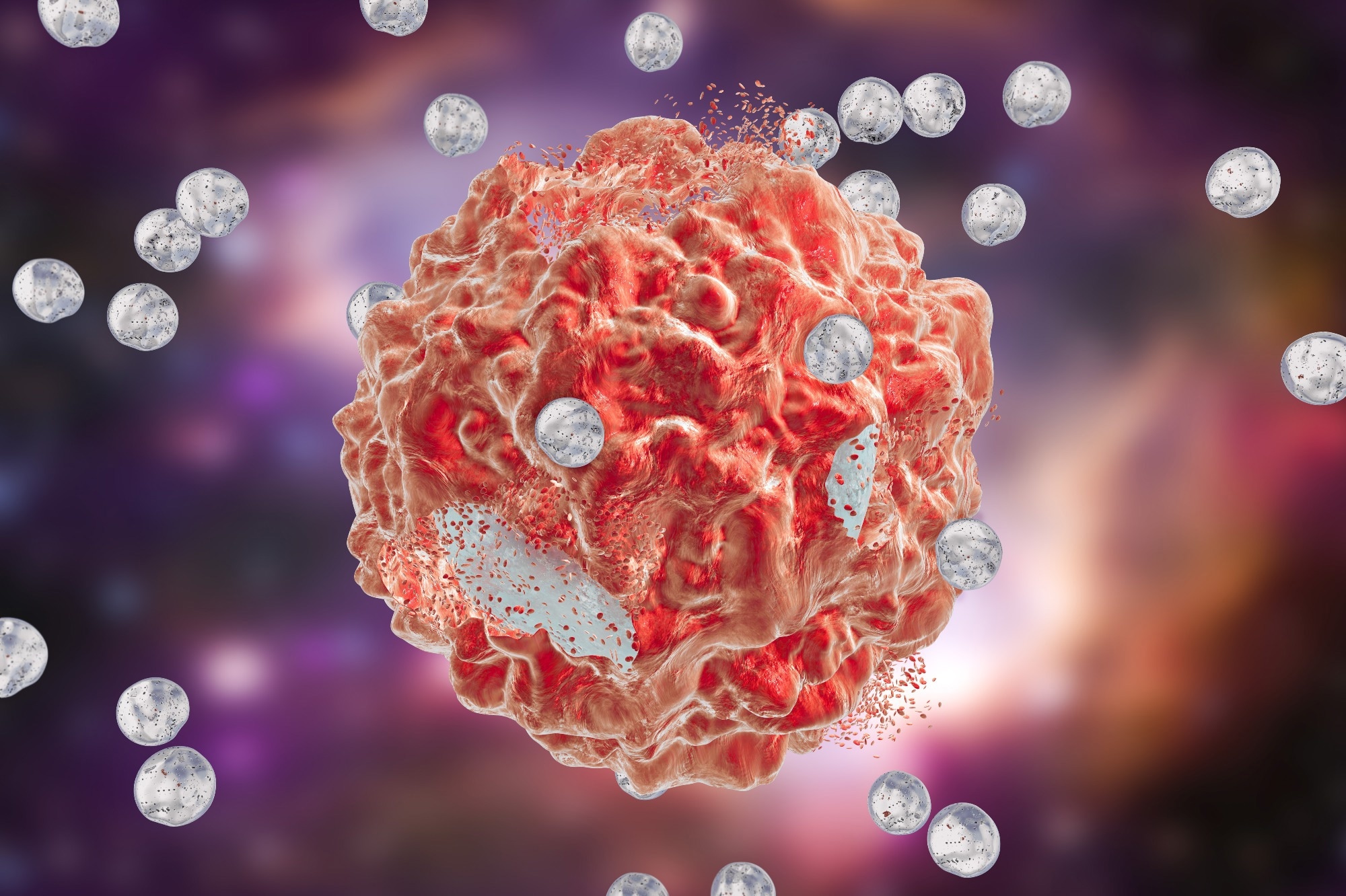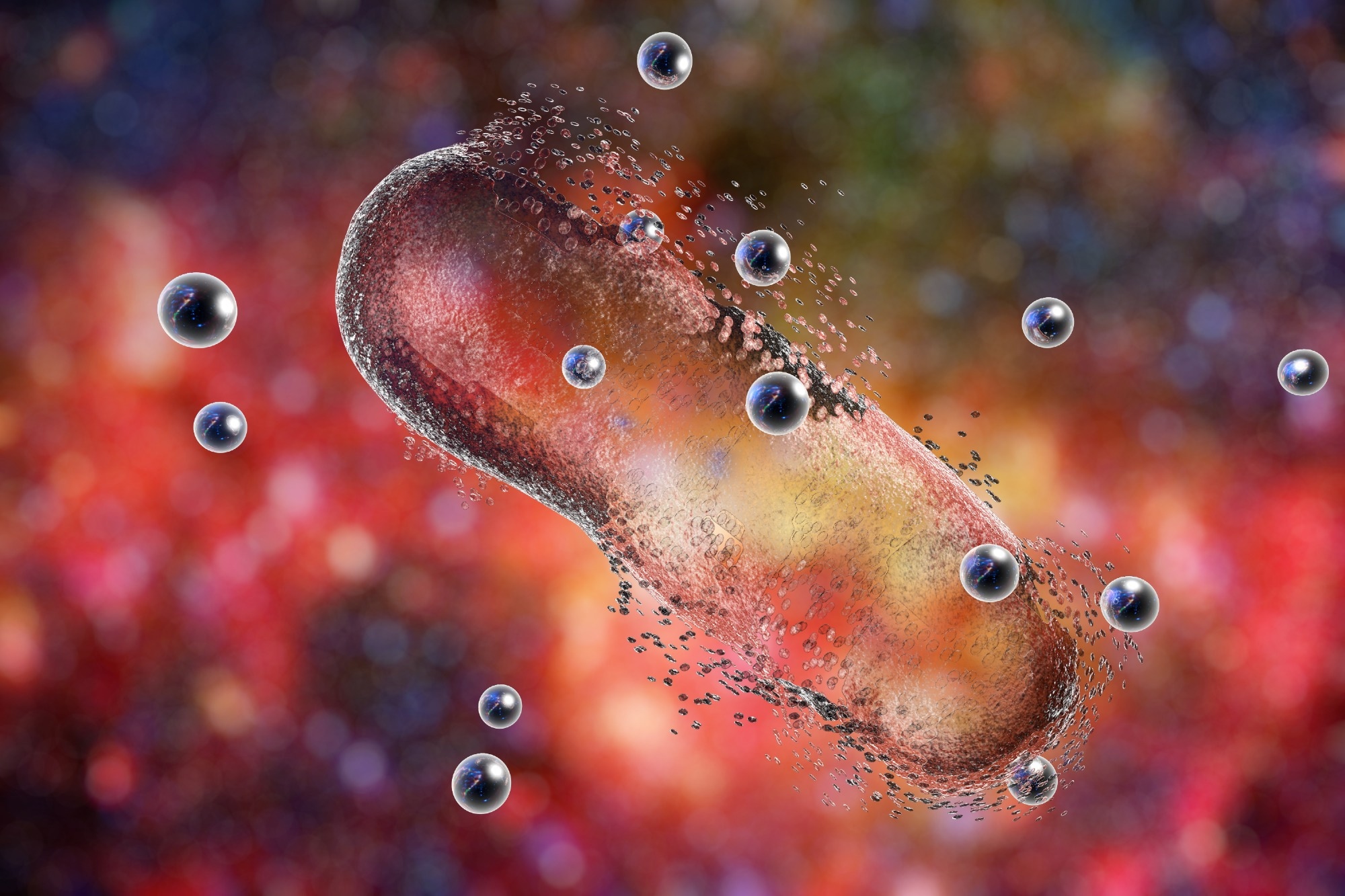How is nanotechnology currently used in medicine?
What does the future of nanomedicine hold?
References
Further reading
Nanomedicines are any therapeutic or diagnostic agent with dimensions on the nanoscale, typically 1 - 100 nm, placing them on a scale comparable with proteins and viruses, small enough to enter cells and interact with cellular machinery in a manner not possible of small molecule therapeutics.
 Destruction of a tumor cell by nanoparticles. Image Credit: Kateryna Kon/Shutterstock.com
Destruction of a tumor cell by nanoparticles. Image Credit: Kateryna Kon/Shutterstock.com
Nanomaterials may themselves act as diagnostic or therapeutic agents or may be utilized in the optimized delivery of traditional small molecule drugs or other cargo, such as proteins, nucleic acids, or large biomolecules. Recent advances in the use of nanomaterials in medicine will be discussed, and the potential of future nanomedicines explored.
How is nanotechnology currently used in medicine?
Several coronavirus 2019 (COVID-19) vaccines utilized nanoscale liposomes in the delivery of mRNA instructing for the production of the severe acute respiratory syndrome coronavirus 2 (SARS-CoV-2) spike protein with great success, protecting the sensitive nucleic acids from degradation during circulation and allowing direct translation across the cell membrane into the cytoplasm of cells throughout the body.
While the mRNA vaccine component of the COVID-19 vaccines was relatively novel, liposomes have been used for drug and diagnostic agent delivery in patients for multiple decades, the first liposomal formula FDA approved in 1995 for the delivery of chemotherapeutic drug doxorubicin.
Encapsulation of this highly toxic drug within liposomes extends circulation time and reduces side effects, promoting biocompatibility and safety, and liposomes have therefore since been adapted to various roles in nanomedicine, over a dozen specific chemotherapeutic-containing liposomal drugs currently FDA-approved as of 2022.
Nanomaterials constructed from alternative materials such as organic polymers, metals, and metal oxides, present a number of additional advantages that may be exploited in nanomedicine, though represent a smaller proportion of approved materials.
In one of their most basic diagnostic applications, the high density of metallic and metal oxide nanoparticles can allow them to be used as contrast enhancers during X-ray imaging, while magnetic nanoparticles such as those constructed from iron oxide have been used as magnetic resonance imaging (MRI) contrast enhancers.
Nanoparticles constructed from plasmonic materials such as gold and silver engage in a phenomenon known as surface plasmon resonance, the in-phase oscillation of conduction band electrons belonging to the nanomaterial with incident light. This phenomenon leads to the intense adsorption of light at the in-phase oscillation wavelength, trailing off rapidly at higher and lower wavelengths as cohesion is lost, and is generally observable by the eye as a particular color.
For example, gold nanoparticles around 10 nm in diameter absorb light 520 nm in wavelength very strongly, at the blue/indigo end of the visible spectrum, and thus a colloidal dispersion of the particles appears red since light of these wavelengths is not absorbed. The particular wavelength of light that engages in surface plasmon resonance is dependent on the size, shape, and material composition of the nanoparticle and its immediate surroundings, and can be tuned throughout the visible and into the near infra-red regions.
Gold nanoparticles are already used as colorimetric indicators in several products, including commercially available pregnancy tests and SARS-CoV-2 testing kits.
The particles within these indicators are coated with molecules that will only interact with specific target molecules, in these cases hormones related to pregnancy or the SARS-CoV-2 spike protein, respectively, and are thus bound to an indicator line or to one another in their presence, causing the appearance of a colored line or the shift of an existing indicator from red to blue as the particles coagulate.
This same principle can allow nanoparticles to be used as in vivo biomarkers and diagnostic probes, since near infra-red light is able to penetrate several tens of millimeters through biological tissue safely, starkly indicating the location of target biomolecules to complimentary molecules bound to the surface of the particle.
One of the few FDA-approved gold nanoparticle formulations is known as Aurolase, which exploits surface plasmon resonance to quickly heat the nanoparticles by the application of high energy light of the resonance wavelength in a technique known as thermal ablation. When properly localized within the tumor a local tissue temperature rise of only a few degrees is sufficient to cause protein denaturation and lead to apoptosis.
Other types of radiation therapy may be enhanced using nanoparticles localized to the target site, and therefore allow a lower overall dose of radiation to be delivered with equivalent efficacy. For example, incident photons are capable of ejecting inner-shell electrons upon collision with nanoparticles, causing those in the valence shell to fall to fill the gap.
The difference in energy between the electron and electron hole is emitted as a photon and may subsequently encounter and eject a second inner-shell electron, repeating the process. The large reservoir of delocalized electrons available to many metallic nanoparticles allows numerous low-energy electrons to be emitted in this way in a process known as an Auger cascade, though no formulation explicitly exploiting this process is yet approved.
 Destruction of a bacterium by silver nanoparticles. Image Credit: Kateryna Kon/Shutterstock.com
Destruction of a bacterium by silver nanoparticles. Image Credit: Kateryna Kon/Shutterstock.com
What does the future of nanomedicine hold?
As discussed, nanomaterials can be imbued with targeting functionality by the incorporation of ligands that present a complementary structure to the target molecule to their surface, perhaps best represented by the addition of antibodies to a specific antigen, ensuring extremely high specificity.
Besides their use as diagnostic agents, nanomaterials are therefore broadly explored as drug or therapeutic delivery agents in examples of personalized medicine, where the specific disease, symptomatology, and patient may be considered during the design of the medicine.
For example, while broad delivery of the mRNA SARS-CoV-2 vaccine to cells throughout the body was beneficial to ensuring widespread spike protein production and subsequent immunogenicity, the delivery of chemotherapeutic drugs should be specific to diseased cells only.
Many types of cancer cells exhibit the over-expression of cell surface protein and glycan receptors particular to the disease, and can therefore be preferentially targeted using this method.
Similarly, specific tissues and organs can be targeted for the delivery of therapeutic cargo in any number of further cases where improved retention time and specificity are desired, such as in the delivery of therapeutic proteins that could be highly toxic if delivered to the wrong site.
The immediate goal of nanomedicine is to provide safe and specific solutions to problems presented by existing medicine, namely making the delivery of otherwise undeliverable therapeutics achievable through improvements in solubility and retention time, and by providing protection during circulation.
The innate properties of nanomaterials themselves will be increasingly exploited in both diagnostic and therapeutic procedures, with increasing opportunities to impart target specificity to the disease, demographic, and individual levels.
References
- Liu P, Chen G, & Zhang J (2022). A Review of Liposomes as a Drug Delivery System: Current Status of Approved Products, Regulatory Environments, and Future Perspectives. Molecules, 27(4), 1372. https://doi.org/10.3390/molecules27041372
- Yin L, Yuvienco C, & Montclare JK (2017). Protein based therapeutic delivery agents: Contemporary developments and challenges. Biomaterials, 134, 91–116. https://doi.org/10.1016/j.biomaterials.2017.04.036
- Rastinehad AR, Anastos H, Wajswol E, Winoker JS, Sfakianos JP, Doppalapudi SK, Carrick MR, Knauer CJ, Taouli B, Lewis SC, Tewari AK, Schwartz J A, Canfield SE, George AK, West JL, & Halas NJ (2019). Gold nanoshell-localized photothermal ablation of prostate tumors in a clinical pilot device study. Proceedings of the National Academy of Sciences, 116(37), 18590–18596. https://doi.org/10.1073/pnas.1906929116
Last Updated: Jul 18, 2023